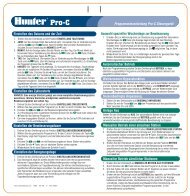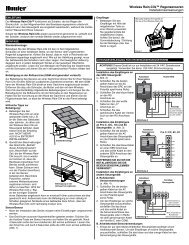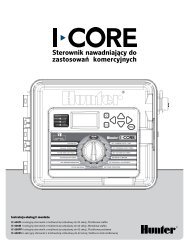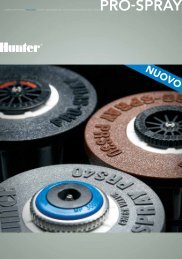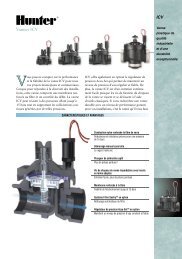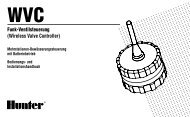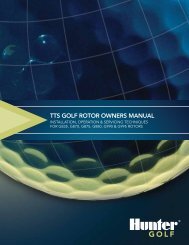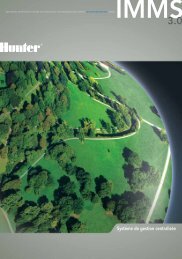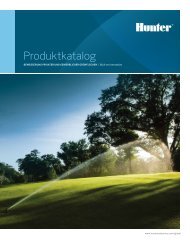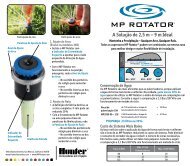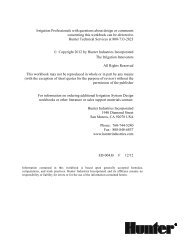The handbook of Technical irrigaTion informaTion - Hunter Industries
The handbook of Technical irrigaTion informaTion - Hunter Industries
The handbook of Technical irrigaTion informaTion - Hunter Industries
You also want an ePaper? Increase the reach of your titles
YUMPU automatically turns print PDFs into web optimized ePapers that Google loves.
Formulas – HydraulicsFriction Factor Pipe SizingThis Friction Factor is used to determine the maximum flow in gallons per minute through any section <strong>of</strong>lateral line pipe while not exceeding a predetermined pressure loss (pressure variation). In order to minimize unevendistribution, sprinklers should operate with pressure variation between sprinklers <strong>of</strong> not more than ± 10 to ± 20% <strong>of</strong>the desired sprinkler operating pressure.F f = P o x P vL cWhere:F f = Friction Factor, the allowable pressure loss per 100 feet <strong>of</strong> pipe, in PSIP o = sprinkler operating pressure in PSIP v = Pressure Variation allowed between the valve and the last sprinkler on the circuit being sized, usually10% or 20% <strong>of</strong> the desired sprinkler operating pressureL c = Critical Length <strong>of</strong> pipe from control valve to farthest head in hundreds <strong>of</strong> feetExample:A) You must determine the amount <strong>of</strong> pressure variation you can allow between the valve and the last sprinklerhead. This is usually 10% to 20% <strong>of</strong> the operating pressure <strong>of</strong> the sprinklers on that particular section. For thisexample we will use 10% (0.10) variation.If a control valve operates a group <strong>of</strong> sprinklers which require 30 PSI to operate (operating pressure = Po) the 10%pressure variation (pressure variation = Pv) would allow a total variation <strong>of</strong> 3.0 PSI from the valve to the farthesthead. (.10 x 30 PSI = 3.0 PSI)B) Determine the Critical Length (L c )Next you must determine the distance the water travels from the control valve to the farthest head. That is notnecessarily the total length <strong>of</strong> pipe in the section but just the length <strong>of</strong> the pipe through which the water flowsfrom the valve to the farthest head. Divide this number by 100 to determine the hundreds <strong>of</strong> feet from the valveto the farthest head. This is called the Critical Length and represents the hundreds <strong>of</strong> feet <strong>of</strong> pipe in which youcan afford to lose the pressure you determined was acceptable for pressure variation in step “A” above.20 feet= Control Valve for these sprinklers= Sprinkler Head requiring 30 PSIand delivering 2.0 GPM at that pressure40 feet80 feet 40 feet 60 feetFig. 1In this diagram you must decide the path the water flows from the valve to the farthest head and calculate thatdistance in feet. <strong>The</strong> water flow path is shown below (Fig. 2) and is represented by the pipe with the check pattern.Notice the distance <strong>of</strong> the branch line is NOT included in the distance. This is because the water flowing to thefarthest head does not travel down that length <strong>of</strong> pipe and therefore any pressure losses occurring in the branch doesnot affect the pressure in the Critical Length.5



